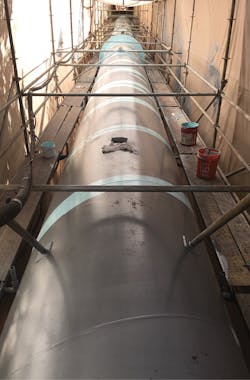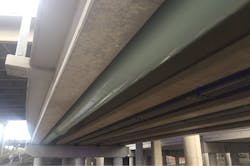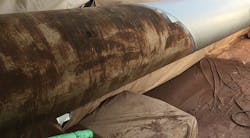Rehabilitating Houston's Above-Grade, Large-Diameter Water Lines
By Christine Kirby
Houston is the fourth most populous city in the U.S. with a population of about 2.3 million extending across 600 square miles. The city produces and distributes more than 146 billion gallons of water per year, enough to fill the Astrodome four times per day. Within the massive water system comprised of water lines from 4 inches to 96 inches in diameter, there are more than 300 above-grade crossings that are 12 inches in diameter and larger, some of which have been in service for nearly 80 years.
Weld seam brush coating on 60-inch water line.
In 2012, the city's corrosion engineering consultant inspected every above-grade crossing to determine the condition of the existing coating, and determine if hazardous materials, including heavy metals and asbestos, were present. Of the crossings that were inspected, various types of coatings were found, including paint, tape wrap and coal tar enamel.
During this study, more than 200 crossings were identified for rehabilitation or replacement, with 21 of these crossings being 24 inches in diameter and larger. In 2014, as part of the city's Surface Water Transmission Program (SWTP), Lockwood, Andrews & Newnam Inc. (LAN), a planning, engineering and program management firm, was hired to conduct a field assessment and provide recommendations for the 21 large-diameter crossings.
Condition Assessment
As part of this effort, a comprehensive field assessment was performed on the 21 crossings, and various characteristics of each crossing were evaluated based on a rating system. Pipeline elements that were assessed included: condition of remaining coating system, pipe exterior surface, saddle cushion, pipe guard functionality and pitting. Structural elements that were assessed included: condition of concrete elements and reinforcement, and condition of steel. Also, as part of the assessment, field measurements were taken, including pipe outer diameter, pipe-to-soil potentials, and pipe thickness using a thickness gauge.
Based on the results of the field inspection and a weighted matrix, a structure priority and a pipe priority were given, which allowed an overall priority list to be developed. A pipeline recommendation to replace or rehabilitate was assigned, and a structural recommendation on whether or not the pipe bridge should be replaced was given.
Also included with the inventory was data on hazardous materials testing. In some of these crossings that had been in service for many decades, residues of lead, cadmium, and chromium were found, along with asbestos on the exterior of the pipe.
Four of the 21 crossings were identified for complete replacement. Two of the crossings were identified for removal. The remaining 15 crossings were identified for recoating. The work was implemented through two separate design and construction packages known as Above Grade Crossings Packages 1 and 2.
Coating Solutions
In field conditions, surface preparation is proven to be more challenging than in the factory. The best surface preparation that could be achieved in the field is SSPC SP6 – Commercial Blast Cleaning, and in tight spaces, only a hand tool or power tool clean could be used. In light of this, LAN researched coating systems for field application over old coatings. Both spray-applied systems and tape-encapsulation systems were compared based on cost, ease of application, and surface prep requirements.
For all the crossings, a coating system by Carboline consisting of a high-solids mastic, a primer/sealer designed for marginally prepared surfaces, and a high-gloss, high-build, two-component polyurethane finish coat was selected as the best fit for expected conditions. At the pipe-to-soil interface, a tape wrap coating system with a reinforced outer wrap was specified.
After: 30-inch water line at Capitol and Buffalo Bayou.
Surface preparation was done using SSPC SP6 – Commercial Blast Cleaning on surfaces wherever possible. Where blast cleaning was not feasible, SSPC SP3 – Power Tool Cleaning was used. The contractor also used SSPC SP2 – Hand Tool Cleaning occasionally. General cleaning of the pipe was required prior to abrasive blast cleaning for the entire length. Evaluation of surface profile was tested using a TesTex pressure-sensitive tape, and holidays and mil thickness testing were completed by a NACE-certified inspector.
Soluble salts present in the air can adhere to the pipe and cause salt-induced corrosion and premature coating failure. To avoid this, the entire pipe surface was power washed with a soluble salt removal solution and tested often to ensure that salts were adequately removed prior to applying primer.
Project Challenges
Blastco Texas, a TF Warren Company, served as the general contractor for the project. According to Steve Wissing, the company's general manager, one of the many challenges was the wide proximity of the crossing locations. The 15 sites were scattered over a 600-square-mile area. As such, the contractor's approach was to "leap frog" from one location to the next after the initial mobilization. As the scaffolding and containment were being torn down at one location, the contractor mobilized and set up scaffolding at the next crossing. Material and equipment were stored off site and brought in each day.
At each site, the contractor set up the scaffolding prior to beginning work. One of the sites that proved particularly challenging was at Capitol and Buffalo Bayou, located in the heart of downtown Houston, where a 30-inch water line is tucked underneath the structure of a roadway bridge. At this site, the scaffolding was hung beneath the roadway, rather than installing supports within the bayou.
Before and After: 60-inch water line at Sims Bayou.
The scaffolding structure was used as frame for the containment set up. A vapor blaster, which uses a very small amount of media, was used at this location to minimize the amount of grit being used. After the work was completed at this site, the contractor was in the process of disassembling the scaffolding when Hurricane Harvey brought catastrophic flooding in Houston, leaving the bridge submerged for days. Remarkably, after the flood water receded, the remaining scaffolding was still in place.
Another challenging site was a 60-inch water line crossing that spanned across Sims Bayou, with the City of Houston's Glenbrook Golf Course on the east side, and an easement on a private residence on the west. Because of space constraints within the private property easement, the contractor's primary access was from the golf course side. Excessive rain just before the contractor mobilized made it difficult to transport equipment through the golf course.
Scaffolding was set up from the north side of the bayou and built across the entire stretch of the crossing into the private property side. With the length of the crossing being approximately 265 linear feet, heavier equipment was necessary to allow blasting and coating. With limited access, completing the coating on the 60-inch crossing took more time than normal.
Before and After: 24-inch water line on Old Galveston Road.
Hazardous Materials
Some of the sites had lead paint concentrations exceeding maximum allowable levels, which required compliance with federal, state, EPA, and OSHA safety regulations. An Environmental Health and Safety Plan detailing plans for soil analysis and air monitoring, handling and site storage, testing of debris, transportation, disposal, worker protections, and notification procedures was implemented. Containment was set up and secured to prevent any material from escaping. Employees used personal air monitors to ensure that their exposure was below OSHA prescribed limits. A decontamination area, including a hand wash station, was set up for workers to clean off and remove contaminated clothing articles prior to exiting the containment. Air monitors were stationed around the site to make sure no contaminants escaped the containment area.
The abrasive material used on the lead paint sites was coal slag mixed with Blastox, which is a chemical that renders the lead unleachable and, therefore, no longer hazardous. The contractor tested the blasted material using TCLP 11 to identify which metals were present. Using the Blastox additive, the blasted material was disposed of in a standard landfill. Any personal protection equipment (PPE) or dust that was identified as hazardous was disposed of in 55-gallon drums and transported to an industrial hazardous waste site.
Soil samples were done before starting the work, and after completing the work, to ensure that soil contamination was not increased due to the recoating activities.
Surface preparation and primer inside containment.
Conclusion
Despite numerous challenges, all 15 sites were successfully recoated, and substantial completion for Above Grade Crossings Package 1 was issued in January 2018. The second package is currently in design and includes replacement of four locations, scheduled to begin construction in late 2019. WW
About the Author: Christine Kirby, P.E., is a project manager at Lockwood, Andrews & Newnam Inc. (LAN), a national planning, engineering and program management firm. She can be reached at [email protected].
Circle No. 227 on Reader Service Card





